Croydon Horse Tramways
History
The first tramways in Croydon were promoted by local interests, a company — the Croydon Tramways Company — being formed in 1877 to build and operate them. Croydon Local Board gave its blessing to the enterprise on the 8th January 1878, the resulting Bill receiving Royal Assent on the 12th July that year.
Construction of the standard-gauge horse tramway started on the 6th May 1879, the first section (running southwards from Thornton Heath Pond along London Road to a point near Station Road in North End) opening on the 9th October 1879. This line was extended southwards along North End to 'The Crown', at the junction with George Street, on the 1st January 1880. At the same time, branches were opened to 'The Gloster' on White Horse Road, and to Windmill Bridge on St James Road, both initially running northwestwards from London Road along Oakfield Road before diverging. The St James branch was, however, not a success, and appears to have been quickly closed. The last line to be opened under the original powers was in effect a southward extension of the North End line along South End and Brighton Road to 'The Red Deer' in South Croydon (opened 14th May 1880); however, due to the narrowness of the thoroughfare in High Street, there was a gap in the system, the new line commencing at 'The Green Dragon' in South End.
New powers were obtained in 1880 to build further extensions, the first of them opening on the 15th January 1881 (eastwards from 'The Crown' along George St to East Croydon Station, which was extended further on the 6th March 1881 to 'The Alma' in Addiscombe), and the second on the 12th December 1881 (northeastwards from Thornton Heath Pond, along Brigstock Road to Thornton Heath, whereupon it proceeded southeastwards along White Horse Road to meet the existing line at 'The Alma'. The company seems to have had quite a thing for pubs, no less than five of its termini being situated outside them!
Although the system was in two halves, the tramway was both well supported and profitable. Unfortunately, things were to take a turn for the worse with the appearance of the Norwood and District Tramways Company, which planned to build a small system around South Norwood — under powers obtained on the 24th July 1882 — that would connect to the CTCo termini at 'The Gloster' and 'The Alma'. The N&DTCo was, however, unable to raise enough capital to begin construction, so an approach was made to the CTCo with a proposal to merge the two companies and then expand as planned. The CTCo agreed, a move which it no doubt came to regret, and a new company — the Croydon and Norwood Tramways Company — was formed on the 2nd August 1883.
The C&NTCo leased operation of the system to the Steam Tramways Traction Company Ltd, a subsidiary of the City of London Contract Corporation, a dubious concern that would prove to be the undoing of many a tramway company. Although the professed aim of the STTCo was to introduce steam-hauled services, using fireless engines, its efforts were a total failure, the new engines only managing to run trials rather than revenue-earning services. The STTCo finally threw in the towel on the last day of 1884, the C&NTCo taking over operation of its 6.79 miles of tramway the following day (1st January 1885). The company was, however, in difficulties, having effectively spent all its money on constructing lines that proved to be completely unremunerative (from the Alma along St James Road East and Portland Road to South Norwood, and from there along Selhurst and Northcote Roads to 'The Gloster', with a branch along Clifton Road connecting to the Thornton Heath line). Although the company struggled on, abandoning some lines by the simple expediency of not running services, on the 25th October 1887 the game was finally up, and a liquidator was appointed.
After much wrangling, a new tramway company was formed (on the 26th August 1889), which was effectively the old company shorn of its useless partner; it even had the same name, though it was a de facto newly constituted company. The new company took over the assets of the C&DTCo from the liquidator on the 1st January 1890, the Clifton Road line and the long loop from South Norwood to 'The Alma' being formally abandoned. During the following decade, the company appears to have been operated profitably, the only development of note being trials of new technology — battery-electric traction and gas traction — though the company adopted neither.
On the 6th June 1897, the two halves of the system were finally connected, the narrow thoroughfare between the North End and South End termini having undergone major restructuring (demolition and widening); the new line was built and owned by Croydon Corporation, from whom the company leased it. This was a harbinger of things to come, the corporation formally deciding — on the 16th October 1899 — to purchase the tramway and convert it to electric traction; it also decided that rather than operate the system itself, the proposed electric tramway would be leased to the British Electric Traction Company.
The corporation duly acquired the horse tramway (on the 22nd January 1900), the operation of which was probably taken over by the BETCo (this is unclear), even though an agreement with the latter was not formally signed until March 1900. The first electric service ran on the 26th September 1901, with the final horse tram being withdrawn in late January or early February 1902 (the precise date appears not to have been recorded).
Uniforms
In common with the majority of horse tramways in the British Isles, conductors and drivers simply wore heavy duty, informal attire: trousers, jackets, shirts and ties, along with heavy topcoats in colder weather. Some drivers also wore heavy leather aprons, a common accoutrement of the horse-drawn transport trade. Headgear tended to follow the fashion of the day, initially the bowler hat, with other styles — such as trilbies and straw boaters — making an appearance in the closing years. Other than the mandatory Public Carriage Office enamel licence badges (see link), no badges of any description were worn on either the jackets or the hats.
Surviving records indicate that the horse tramway employed five foremen/inspectors in the early 1900s; however, as no photographs of these individuals are known, it is currently impossible to say whether they were provided with uniforms.
Further reading
For a history of Croydon's horse tramways, see: 'The Tramways of Croydon' by G E Baddeley; Light Rail Transit Association (1983).
Images
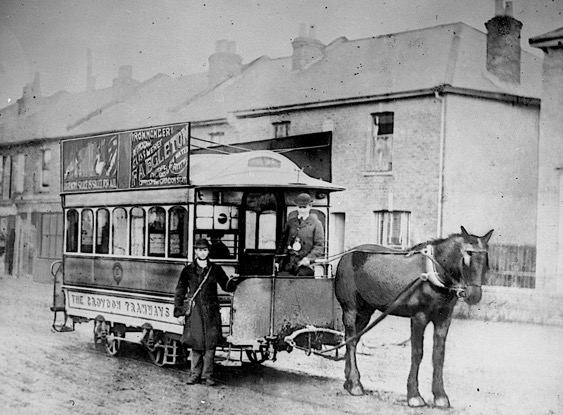
Horsecar No 8 at 'The Red Deer' terminus in South Croydon— photo purportedly taken in 1885, when services would have been directly operated by the Croydon and Norwood Tramways Company (of 1877). Photo courtesy of the National Tramway Museum. 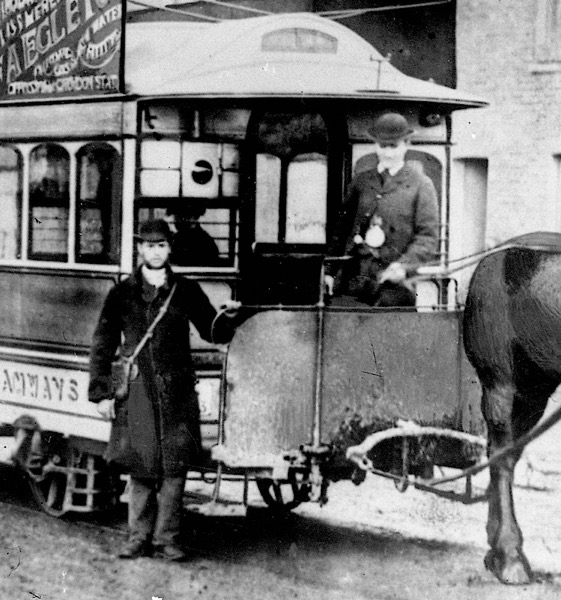
An enlargement of the above photograph showing the conductor and the driver. Both men are wearing informal attire, along with large oval enamel PCO licence badges issued by the Metropolitan Police. Photo courtesy of the National Tramway Museum. 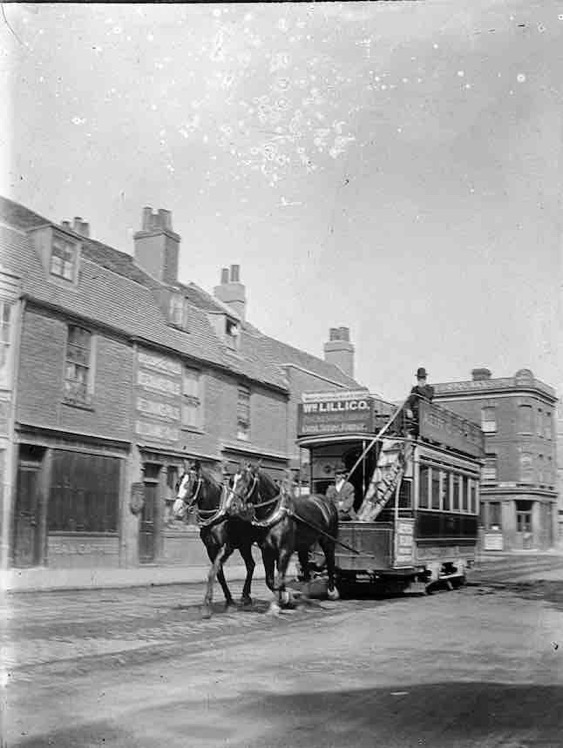
Horsecar Number 31 on a Thornton Heath service — photo undated, but certainly taken no earlier than May 1897, when Nos 24 to 31 seem to have replaced older single-deck cars. Author's Collection.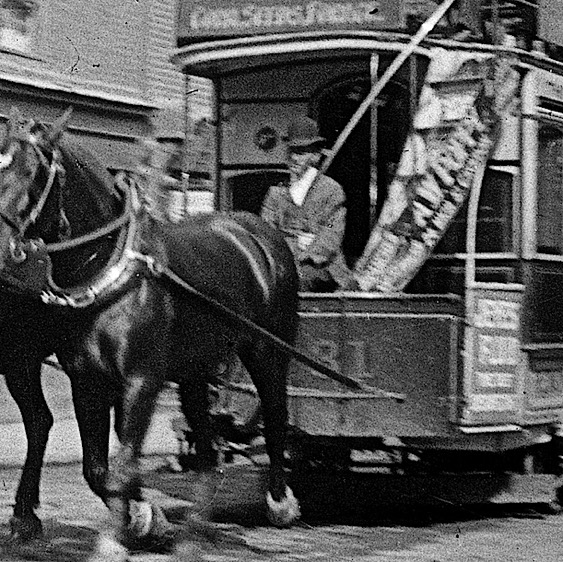
An enlargement of the above photograph showing the driver, in informal attire, and with the tall style of bowler hat much favoured by horse tram and bus drivers.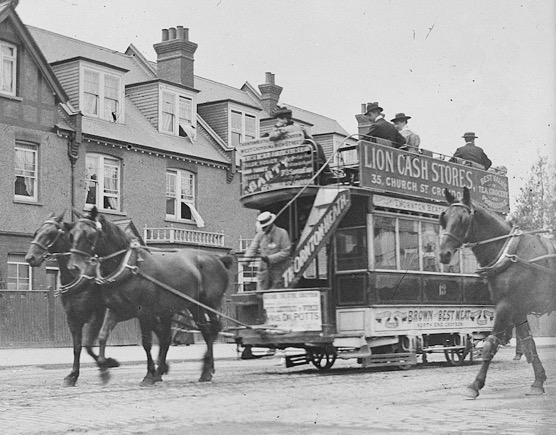
Horsecar No 13 on a Thornton Heath service — photo undated, but judging by the fashions, probably taken in the late 1890s. Author's Collection.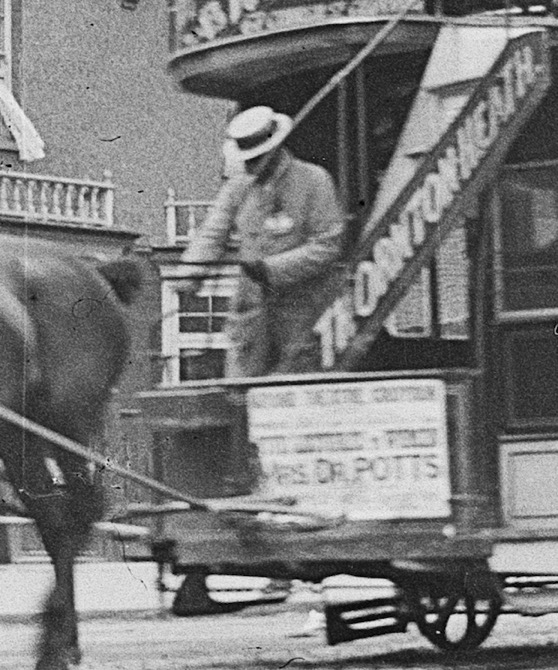
An enlargement of the above photograph showing the driver, who appears to be wearing a light-coloured raincoat, along with a straw boater, and the usual PCO licence badge.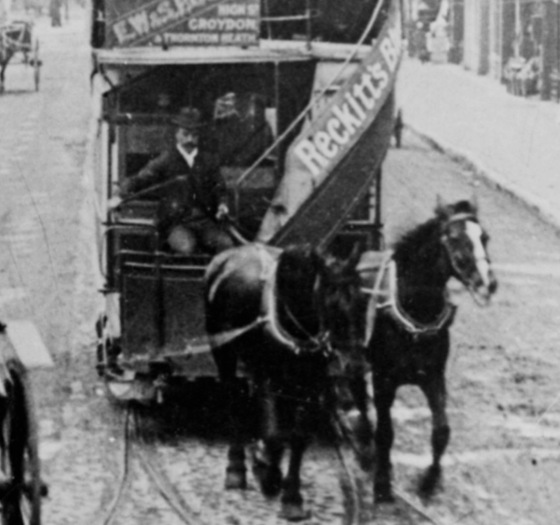
An unidentified horsecar on the move in London Rd — photo undated, but probably taken in the mid-to-late 1890s. The driver appears to be wearing a trilby. Photo courtesy of the Tramways and Light Railway Society, with thanks to David Voice.